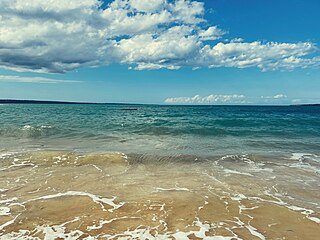Related Research Articles
Likoma District consists of two separate exclaves of Malawi situated within Mozambican waters in Lake Malawi. It consists of two main islands, Likoma and Chizumulu. It is a district in the Northern Region of Malawi. The capital is Likoma.
The Mwera people are an African ethnic and linguistic group. They are found in southeast Lindi Region, Mtwara Region, and Ruvuma Region of Tanzania, as well as around the border regions between Tanzania and Mozambique.
Émile Bertrand Mbamba is a Cameroonian football striker, who currently plays for Indonesia Super League side Bhayangkara F.C.. He also played for Vitesse Arnhem, Maccabi Tel Aviv, Maccabi Petah Tikva, Vitória Setúbal, Arema Malang, Daegu FC and Botev Plovdiv.

The 250 or so "Narrow Bantu languages" are conventionally divided up into geographic zones first proposed by Malcolm Guthrie (1967–1971). These were assigned letters A–S and divided into decades ; individual languages were assigned unit numbers, and dialects further subdivided. This coding system has become the standard for identifying Bantu languages; it was the only practical way to distinguish many ambiguously named languages before the introduction of ISO 639-3 coding, and it continues to be widely used. Only Guthrie's Zone S is (sometimes) considered to be a genealogical group. Since Guthrie's time a Zone J has been set up as another possible genealogical group bordering the Great Lakes.

Álvaro III Nimi a Mpanzu, also known as Álvaro III Mbiki a Mpanzu, ruled as king or manikongo of the Kingdom of Kongo from August 1615 to 4 May 1622. Prior to becoming king, he had served as Duke of Mbamba. Like his predecessor, Bernardo II he was a son of King Álvaro II. King Álvaro III was the fourth ruler from the royal house of Kwilu established by King Álvaro I. In 1622, Álvaro III died while his son, Ambrósio, was too young to become king. The nobles elected the Duke of Mbamba to the post of mwenekongo, ushering the short dynasty of the House of Nsundi.

Mbamba Bay is a town in western Tanzania, lying on the eastern shore of Lake Malawi/Lake Nyasa.
The Kutubuan languages are a small family of neighboring languages families in Papua New Guinea. They are named after Lake Kutubu in Papua New Guinea.
Mwera can refer to several things related to Tanzania:

Merelava is an island in the Banks Islands of the Torba Province of northern Vanuatu.

The Mtwara–Mbamba Bay Road, also A19 Road, connects the city of Mtwara on the Indian Ocean coast, to the town of Mbamba Bay on the eastern coast of Lake Malawi. It is a busy and important transport corridor in the southern regions of Tanzania. It is also an integral part of the Mtwara Development Corridor that spans four Southern African countries; Malawi, Mozambique, Tanzania and Zambia.
Alvaro VIII, of the House of Kinlaza, was king of the Kingdom of Congo, from 1666 to 1669.
The Lomwe (Lowe) language, Elomwe, also known as Western Makua, is the fourth-largest language in Mozambique. It belongs with Makua in the group of distinctive Bantu languages in the northern part of the country: The Makhuwa-using area proper is separated by a large Lomwe-speaking area from the related eChuwabo, although eMakhuwa neighbours eChuwabo in a more coastal zone. To the south, the rather more distantly related Sena (ChiSena) should be assigned to a group with Nyanja and Chewa, while the distinct group which includes Yao, Makonde and Mwera is found to the north. Apart from the regional variations found within eMakhuwa proper, eLomwe uses ch where tt appears in eMakhuwa orthography: for instance eMakhuwa mirette ("remedy") corresponds to eLomwe mirecce, eMakhuwa murrutthu to eLomwe miruchu, eMakhuwa otthapa ("joy") to eLomwe ochapa.
The Rufiji–Ruvuma languages are a group of Bantu languages established by Gloria Waite (1979) and subsequent researchers: N10, P10, P20.
The Nyasa languages are an apparently valid genealogical group of Bantu languages. With the reassignment of a couple of Guthrie Zone N languages to other branches, Nyasa is essentially synonymous with Zone N. The languages and their Guthrie identifications are:
Mwera is a Bantu language of Tanzania.

Liuli, formerly known as Sphinx Hafen, is a settlement on the Tanzanian shore of Lake Malawi in the Mbinga District of Ruvuma province. It is notable for being the site of the first naval action of World War I.

The Mtwara Development Project is a major infrastructure development project involving southern Tanzania, northern Mozambique, eastern Malawi and Eastern Zambia. The goal of this project is to provide road, rail and waterway access from the surrounding region to the Port of Mtwara. The region and the corridor has been neglected by the respective governments for over 40 years and the recent discovery of oil, gas and various minerals has kick started the development of the project. A road and rail link is to be built from the port of Mtwara to Mbamba Bay on Lake Nyasa to link Malawi to the corridor and further road links into Mozambique will facilitate access to northern Mozambique.
Noah Mbamba-Muanda, known as Noah Mbamba is a Belgian professional footballer who plays as a defender for Club Brugge.

Lindi Bay is a body of water in located in southern Lindi Region in south east Tanzania. Located in the Indian Ocean, the bay is 11.8km long, 5.9km at its widest and 750m at its shortest. The bay is fed by the Lukuledi River with the mouth of the river into the bay is located the town of Lindi, which is the regional capital of the Lindi region. The bay does not have a shipping port, however, most of the marine vessels are the Lindi Ferry and dugout canoes used by the resident fishermen. The original inhabitants of the bay are the Mwera people.
References
- ↑ Mwera at Ethnologue (18th ed., 2015)
- ↑ Jouni Filip Maho, 2009. New Updated Guthrie List Online